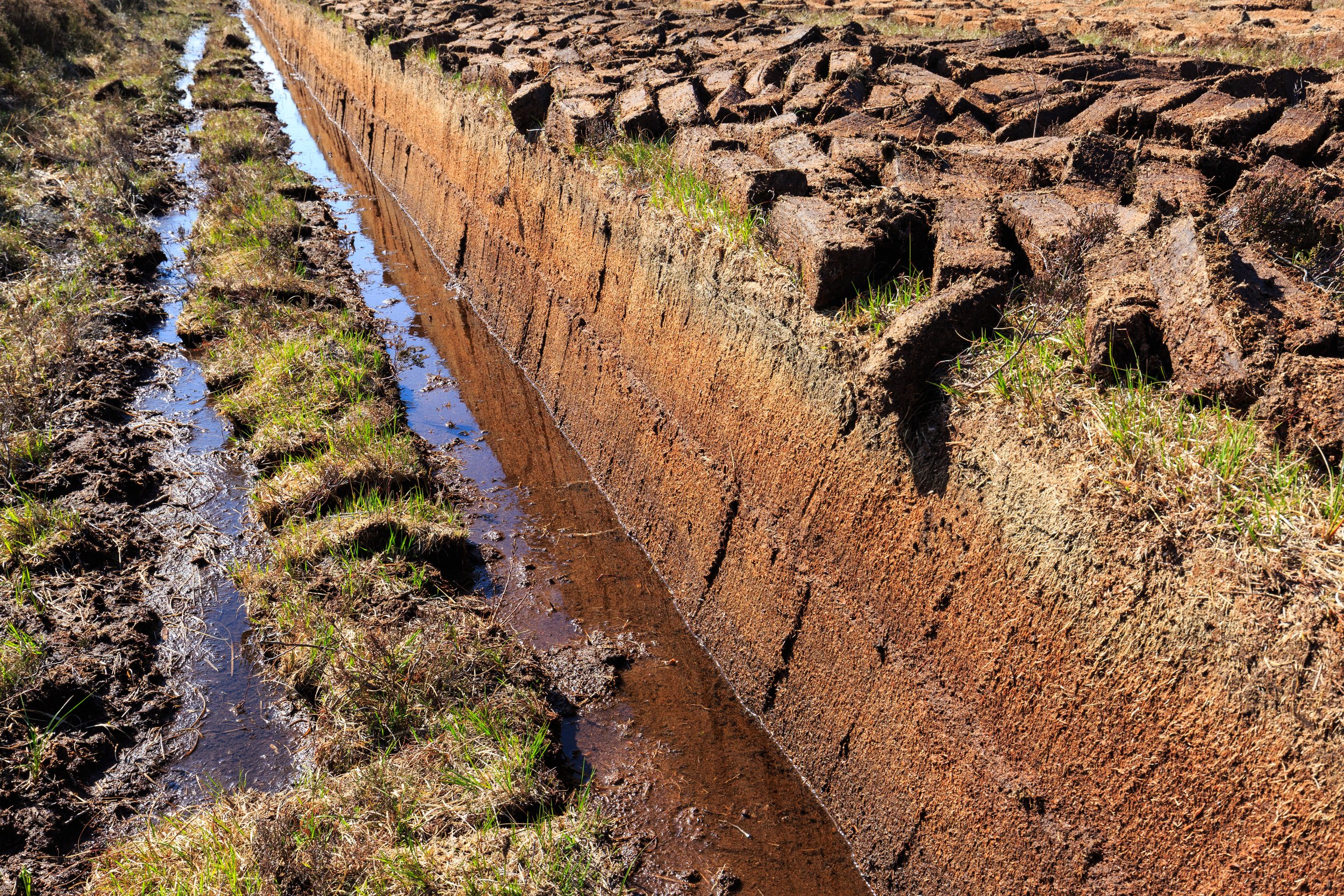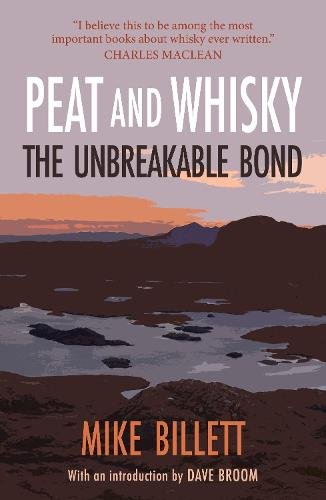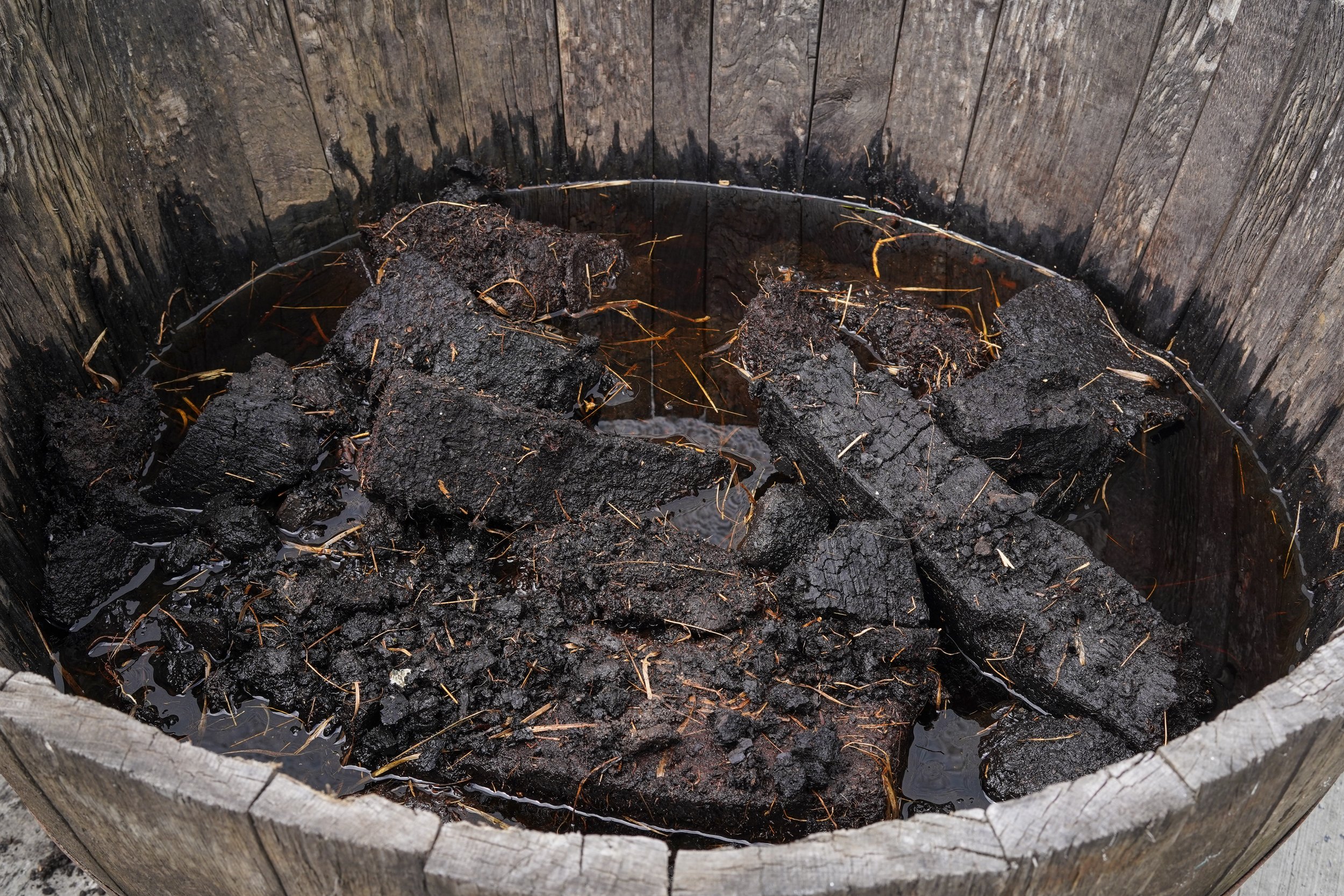Peat and Sustainability
Arthur asks the difficult question for those who love their malty smoke bombs.
Is peat sustainable?
When we first get into scotch, sooner or later, we try our first heavily peated malt. For many, the ripe, strange smokiness of this whisky is instantly compelling. Next, we learn about the source of its intense aroma. We watch footage of the moist peat being dug from the bog — usually it’s the hand-cut variety that’s shown on our screens —and one very simple question begins to nag. Are we going to run out of this stuff?
That simple question leads to a raft of other uneasy queries. How much of a contribution to climate change is whisky making overall? How important is peat in that impact? Is anything being done to replace peatlands? Can peat bogs be replaced at all? Will ‘peat reek’ be taken away from us and become a thing of the past? Ultimately, is this sustainable?
A fair amount has been written online on the subject, but I was yet to be satisfied with the answers I found. On one hand, I found gloomy forecasts about the future of this special aroma; on the other, I found buzzing optimism from some of the bigger producers about their peat regeneration schemes. I suspected there was a fair bit more to the story, nuances to be found, and a variety of different views.
So, I decided to reach out to some industry people to sound out their opinions and see what range of opinions existed. Three individuals, with two directors of new distilleries (Nc’Nean and Ardnamurchan) plus one author who’s recently published on this very topic, got in touch and answered a series of questions revolving around the sustainability of peat.
Before we get there, we should establish what peat actually is. Peat is a mass of vegetation which has been compressed and partly decayed over time. Sphagnum mosses are a notable part of peat, but a wide array of other plants make up the rich material. Not all peat is the same, even within the same bog: the upper layers of peat are coarser, with visible fibres in the structure; lower layers of peat are denser and smoother, the mòine dubh, black peat.
Peat is a precious substance which accumulates over centuries. The estimate of growth is about 1mm a year. The deepest known peat bogs are around 10 metres deep: about 10,000 years of growth. To put this timeframe into perspective, that’s about 5000 years before humans developed written language.
Deeper peats burn cleaner and at higher temperatures, while the coarse peats further up (and that are therefore younger) burn ‘dirty’ and produce more smoke — perfect for imparting flavour on whisky. It’s the diversity and complexity of organic matter in peat that makes its smoke unique, full of phenolic compounds which cling to the dried grains. There’s yet more nuance when it comes to the use of the peats. For example, the classic metric of ‘parts per million’ in the peated malt fails to take account of what happens to the malt after drying, which will transform the flavour of the grains once again.
Peat is cut from the ground, while the bogs must typically be drained by cutting channels into the ground first, which ‘deactivates’ the peat generating process. Peat regeneration, which is the inverse of this process, involves re-wetting the bogs, allowing them to develop once again. That regeneration process is a vital part of the sustainability discussion.
To get a deeper understanding of what peat is beyond this surface-level summary, readers should check out Mike Billett’s very-recently published Peat and Whisky: The Unbreakable Bond. You can find the book here.
With all this in mind, it’s time to see what our interviewees had to say about the relationship between whisky and peat. There are many intriguing details to tease out, and the perspectives are all carefully nuanced — though not always in agreement.
Annabel Thomas
Annabel Thomas founded Nc’nean distillery in 2017 and Nc’nean’s operation is focussed on sustainability. They operate on a carbon neutral basis, with a biomass boiler as their power plant. Where fossil fuels are indirectly involved, they use carbon offsetting to reach the net zero balance. All their whiskies are organic.
In your view, is peat important in making scotch whisky distinctive?
“Not in totality as a category, but it clearly is in making some (famous) whiskies within scotch distinctive.”
Exemplifying the fact that not all scotch is peated — or has to be peated to be scotch— Thomas notes that “as an unpeated scotch we have not found the lack of peat [in Nc’nean] to be a hindrance.”
What can a distillery do to make peat and the use of it more sustainable?
“Ultimately the use of peat cannot be sustainable. So reducing the amount of peat that is used by improving the efficiency of that use (e.g. by recycling smoke) has to be the key action.”
Thomas is sceptical of the efficacy of peatland restoration (the idea that the resource can be replaced). This explains the view that peat use is unsustainable, where others are more hopeful of the prospects of the fuel.
She argues that peatland restoration is “better than nothing” but ultimately “a poor mitigation,” akin to “planting new trees to replace the felled Amazon rainforest.”
Sometimes, Scottish peat, or Scottish peated malt, is exported for other whisky makers globally. What is your view on peat and world whisky?
“Ideally we would not be destroying our carbon sinks and biodiverse habitats for the benefit of whisky — world or scotch.”
However, where the “established tradition or brand identity” and its connection with peat reek might be shaky or non-existent, this is even harder to justify, indeed, “pretty crazy.”
Have you seen a change in attitudes towards peat?
“A small shift, but it is small,” Thomas says and reflects there are still some misconceptions about the basics of peat. She notes the use of peat in compost (which is much more significant at present than the whisky industry’s usage) has brought the subject to more people’s attention but that many are yet to make the connection to the peat used in whisky.
Is the use of peat in Scotch whisky production sustainable?
“No, I don’t believe it is.”
How do you see the future of peat use in whisky making?
Though doubting that scotch whisky’s use of peat in the long-term can be sustainable, Thomas also acknowledges that “if you are Laphroig for example, you have a massive problem on your hands, with centuries of brand built upon a taste profile that is reliant on peat. So the solution seems to me to invest in researching technologies that can improve the efficiency of its use or, perhaps even replace it (e.g. synthetic peat).”
Alex Bruce
Alex Bruce joined Adelphi, an independent bottler in the early 2000s. In 2014, Bruce and the Adelphi team founded Ardnamurchan distillery. In common with Nc’nean, the distillery is highly conscious of climate impact and uses a biomass boiler in combination with hydroelectric power for its energy.
In your view, is peat important in making scotch whisky distinctive?
“Yes. It is one of the main components when creating a unique and distinctive flavour in whisky.”
Do you think the producers who rely on peat are taking appropriate steps to measure the sustainability of their peat use?
“Most whisky producers will buy in most of their malted barley already peated” which makes it difficult for end-users of peated malt, including Ardnamurchan (although they are developing floor maltings) to track the use of peat. Nevertheless, Bruce says “we are increasingly aware of work, by the maltsters, on many steps towards making peat usage more sustainable.”
What can a distillery do to make peat, and the use of it, more sustainable?
“The most obvious ways include using less peat (for the same effect) and actively engaging with peatland restoration. As an industry requiring the use of peat, albeit in relatively small volumes, we are naturally incentivised to ensure long term peat regeneration.”
Bruce also hints at a series of different techniques—some resting on inventions, others simply on skilful control—that can improve the sustainability of peat: “The maltsters are experimenting with tighter management of moisture levels when drying the malt, use of roasting to provide some substitute smoke, and recycling of peat reek from chimneys. Some distillers are looking at different heat sources combined with smaller peat smoke boxes (similar to domestic wood burners) to drastically reduce the volume of peat required, and larger distillers are already actively engaged in funding and working on peatland restoration.”
Sometimes, Scottish peat, or Scottish peated malt, is exported for other whisky makers globally. What is your view on peat and world whisky?
“While this can cause supply issues more locally, Scottish peat has been exported to India, Japan and other parts of the world for over 20 years.” Although there may have been gaps in its recent export history, Billett’s research discussed below shows that the timeframe for peat exports goes even further back, well into the depths of the 19th century.
Bruce adds, pragmatically, that the export of ready-peated malt “is a good additional revenue stream for the maltsters that can in turn be used for research and development.”
Have you seen a change in attitudes towards peat?
Echoing Thomas’ view, Bruce feels that the awareness among consumers of these issues is in its infancy. He has not yet seen a major “change from the consumer side, but certainly more interest in the industry’s use of peat coming from media now. This is likely to increase once horticultural use is restricted and our currently very small percentage use becomes a much larger percentage of the remaining total used.” This is an important point: the Scottish government is considering a ban on the extraction of peat for horticulture.
Is the use of peat in Scotch whisky production sustainable?
“Given the small volumes required (the whisky industry is currently using just 2% of peat extraction in the UK) and the work already being carried out by the maltsters, engineers and distillers, I am confident that we can sustain a level of use.”
Mike Billett
Author
Dr Mike Billett holds a PhD in geology and earth sciences, and has lectured at the universities of Stirling and Aberdeen on the subject. Combining this scientific background with historical research and research in the field (or rather, the bog), he’s recently published Peat and Whisky: The Unbreakable Bond.
In your view, is peat important in making scotch whisky distinctive?
“Without doubt—yes.” Billett points to the long history of peat and its involvement in scotch, and reminds us that it’s “something people look for in many blends and single malts.”
Are producers who rely on peat are taking appropriate steps to measure the sustainability of their peat use?
“In many cases, no,” Billett is careful to note, however, that there is good awareness of the issue in the industry. For the future of whisky’s relationship with peat, “the industry needs [...] guidance and knowledge to develop an appropriate long-term strategy.” That strategy would ultimately need to balance the use of peat with its regeneration: peat does grow back, just very slowly, at a rate of ca.1mm a year. Unfortunately, that’s a rather coarse average and this balancing strategy would need better data and monitoring of peat bogs’ progress.
Another key issue that Billett raises is the fragmented route from peat to dram. “The supply chain involving peat producers, maltsters and distillers” makes it hard for each player to see their role. “In the future, there must be a joined-up and collective approach to the sustainable use of peat.”
What can a distillery do to make peat, and the use of it, more sustainable?
Billett points out that extraction of peat is not the only threat to peatlands, and indeed it may not even be the most important: “drainage, climate change, overgrazing, afforestation and fire are the main culprits.” In solving those problems “there is enormous capacity to restore peatlands and promote their sustainable use.” He also hints at reducing the quantities of peat that are used in the first place by making its use more efficient, something that Alex Bruce fleshes out above.
Sometimes, Scottish peat, or Scottish peated malt, is exported for other whisky makers globally. What is your view on peat and world whisky?
Billett starts by putting ‘global peat’ into a historical perspective, with the fact that “from the 1800s Scottish peat and peated malt have been exported and used by distilleries across the world.” This may be surprising, but Billett’s new book abounds with examples of peat export, with Irish peat travelling to Glasgow and Campbeltown distilleries in the 1880s, Stornoway peat to malting kilns of Edinburgh in the 1830s, and by the 1890s, remarkably, Scottish peat was travelling to distilleries in Australia.
Today, though, Billett argues “decisions will need to be made about prioritisation.” That is, who continues to use peat, and why, shouldn’t be taken lightly. Peat exported over huge distances may become harder to justify (echoing Thomas’ concern). On the flip-side, use of “global peat from bogs with different native plants is an exciting development [...] with potentially new aromas and flavours available to the consumer.”
Have you seen a change in attitudes towards peat?
“As a scientist I have seen a significant change in attitude towards peat over the last 40 years. Peatlands were once seen as barren lands, places to be exploited and often avoided. Scientifically they were relatively unstudied and as a consequence poorly understood. That all changed in the 1980s as the world woke up to biodiversity loss.”
Following a similar trend, Billet also says that he’s been struck by “how often the sustainability issue crops up” in conversations with whisky enthusiasts and members of the industry.
Is the use of peat in Scotch whisky production sustainable?
“I have no doubt that with the right level of commitment and engagement, long-term peat use by the Scotch whisky industry is both achievable and sustainable. But we are not there yet.”
Behind his cautious optimism is the fact that “it is possible to restore most damaged peatlands to ecological health in timescales of 10-20 years, when they once again become effective at trapping and storing atmospheric carbon.”
How do you see the future of peat use in whisky making?
“I find it difficult to conceive of a future when the aroma and flavour of peat is not part of the profile of Scotch whisky, albeit with a more efficient use of peat. The way forward is for the industry to collectively embrace peatland restoration to deliver a sustainable future for peat.”
Concluding thoughts
The relationship between scotch and peat is likely to change significantly in the next few years. Attitudes, ecology, and maltsters’ methods are all being transformed as awareness of the complex, lively substance increases.
Some of the major peat extraction sites received their permission to dig decades ago. One of the most famous, Castlehill Moss, which serves the Port Ellen maltings (and thus much of Islay’s peated malt) had “no limit imposed on the amount of peat extracted.” These were not the words of a provocative whisky commentator, but rather a present-day Argyle and Bute planning officer reflecting on a 1988 application to dig the Castlehill Moss. It’s hard to imagine this point of view being taken by the authorities today, much less them giving out blank cheques for peat exploitation. Taking peat for granted cannot continue for much longer.
So, if the use of peat in scotch is unlikely to disappear completely, its use is going to get a lot smarter. The amount dug, and the amount regenerated, are likely to be closely monitored and controlled. Clever inventions along the way—like smaller chambers to maximise peat reek and minimise peat use—may well lead to new possibilities of flavour. If we are lucky, rethinking peat use might do wonders for Scotch whisky itself, as well as the landscape it comes from.
AB
-
Dramface is free.
Its fierce independence and community-focused content is funded by that same community. We don’t do ads, sponsorships or paid-for content. If you like what we do you can support us by becoming a Dramface member for the price of a magazine.
However, if you’ve found a particular article valuable, you also have the option to make a direct donation to the writer, here: buy me a dram - you’d make their day. Thank you.
For more on Dramface and our funding read our about page here.











